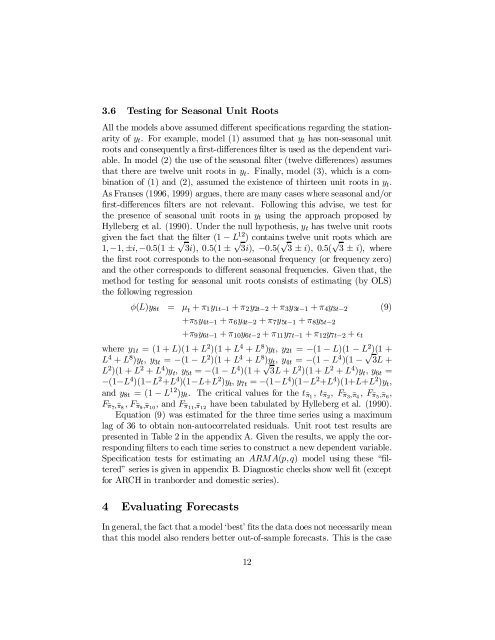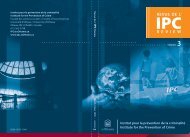0306E - Faculty of Social Sciences - Université d'Ottawa
0306E - Faculty of Social Sciences - Université d'Ottawa
0306E - Faculty of Social Sciences - Université d'Ottawa
Create successful ePaper yourself
Turn your PDF publications into a flip-book with our unique Google optimized e-Paper software.
3.6 Testing for Seasonal Unit Roots<br />
All the models above assumed di¤erent speci…cations regarding the stationarity<br />
<strong>of</strong> y t . For example, model (1) assumed that y t has non-seasonal unit<br />
roots and consequently a …rst-di¤erences …lter is used as the dependent variable.<br />
In model (2) the use <strong>of</strong> the seasonal …lter (twelve di¤erences) assumes<br />
that there are twelve unit roots in y t . Finally, model (3), which is a combination<br />
<strong>of</strong> (1) and (2), assumed the existence <strong>of</strong> thirteen unit roots in y t .<br />
As Franses (1996, 1999) argues, there are many cases where seasonal and/or<br />
…rst-di¤erences …lters are not relevant. Following this advise, we test for<br />
the presence <strong>of</strong> seasonal unit roots in y t using the approach proposed by<br />
Hylleberg et al. (1990). Under the null hypothesis, y t has twelve unit roots<br />
given the fact that the …lter (1 ¡ L 12 ) contains twelve unit roots which are<br />
1; ¡1; §i; ¡0:5(1 § p 3i); 0:5(1 § p 3i); ¡0:5( p 3 § i); 0:5( p 3 § i), where<br />
the …rst root corresponds to the non-seasonal frequency (or frequency zero)<br />
and the other corresponds to di¤erent seasonal frequencies. Given that, the<br />
method for testing for seasonal unit roots consists <strong>of</strong> estimating (by OLS)<br />
the following regression<br />
Á(L)y 8t = ¹ t + ¼ 1 y 1t¡1 + ¼ 2 y 2t¡2 + ¼ 3 y 3t¡1 + ¼ 4 y 3t¡2 (9)<br />
+¼ 5 y 4t¡1 + ¼ 6 y 4t¡2 + ¼ 7 y 5t¡1 + ¼ 8 y 5t¡2<br />
+¼ 9 y 6t¡1 + ¼ 10 y 6t¡2 + ¼ 11 y 7t¡1 + ¼ 12 y 7t¡2 + ² t<br />
where y 1t = (1 + L)(1 + L 2 )(1 + L 4 + L 8 )y t , y 2t = ¡(1 ¡ L)(1 ¡ L 2 )(1 +<br />
L 4 + L 8 )y t , y 3t = ¡(1 ¡ L 2 )(1 + L 4 + L 8 )y t , y 4t = ¡(1 ¡ L 4 )(1 ¡ p 3L +<br />
L 2 )(1 + L 2 + L 4 )y t , y 5t = ¡(1 ¡ L 4 )(1 + p 3L + L 2 )(1 + L 2 + L 4 )y t , y 6t =<br />
¡(1¡L 4 )(1¡L 2 +L 4 )(1¡L+L 2 )y t , y 7t = ¡(1¡L 4 )(1¡L 2 +L 4 )(1+L+L 2 )y t ,<br />
and y 8t = (1 ¡ L 12 )y t . The critical values for the t b¼1 , t b¼2 , F b¼3 ;b¼ 4<br />
, F b¼5 ;b¼ 6<br />
,<br />
F b¼7 ;b¼ 8<br />
, F b¼9 ;b¼ 10<br />
, and F b¼11 ;b¼ 12<br />
have been tabulated by Hylleberg et al. (1990).<br />
Equation (9) was estimated for the three time series using a maximum<br />
lag <strong>of</strong> 36 to obtain non-autocorrelated residuals. Unit root test results are<br />
presented in Table 2 in the appendix A. Given the results, we apply the corresponding<br />
…lters to each time series to construct a new dependent variable.<br />
Speci…cation tests for estimating an ARMA(p; q) model using these “…ltered”<br />
series is given in appendix B. Diagnostic checks show well …t (except<br />
for ARCH in tranborder and domestic series).<br />
4 Evaluating Forecasts<br />
In general, the fact that a model ‘best’ …ts the data does not necessarily mean<br />
that this model also renders better out-<strong>of</strong>-sample forecasts. This is the case<br />
12
















